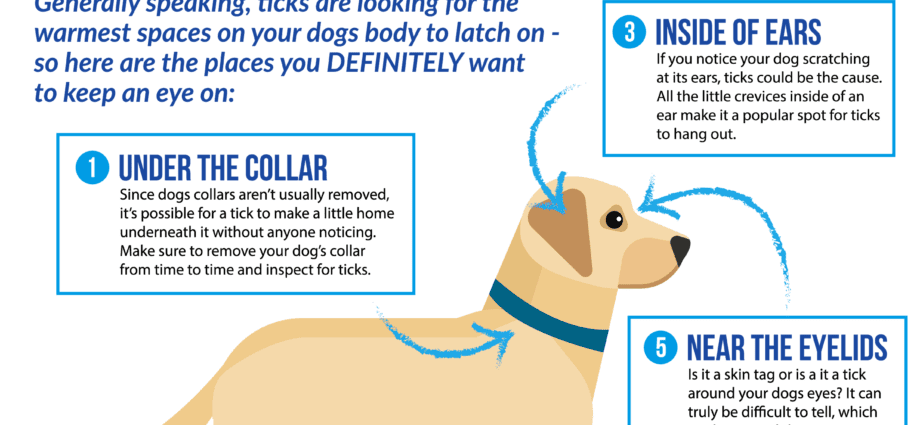Contents
- Lyme disease in dogs: how to detect and treat it?
- How do ticks attack people and dogs?
- What are the symptoms of Lyme disease in dogs?
- How do I know if my dog has Lyme disease?
- How is Lyme disease treated?
- Can I get Lyme disease from my dog?
- How can I prevent my dog from contracting Lyme disease or other tick-borne illnesses?
- What are the other canine diseases transmitted by ticks?
Lyme disease in dogs: how to detect and treat it?
Lyme disease, also known as Lyme borreliosis, is a bacterial disease that can be transmitted to humans, dogs and other animals by certain species of ticks. It is caused by the spiral-shaped bacteria Borrelia burgdorferi which is carried inside a tick and enters the bloodstream of a dog or person through a tick bite. Once in the bloodstream, bacteria can travel to different parts of the body and cause problems in specific organs or places, such as the joints, as well as general disease.
How do ticks attack people and dogs?
Ticks carrying Lyme disease are especially likely to be found in tall grass, thick brush, swamps and woods, waiting to cling to your dog as he passes. A tick can transmit the disease after hanging on a dog for 24 to 48 hours.
The main vector of Lyme disease is the blacklegged tick Ixodes scapularis. The tick ingests the Lyme disease bacteria when it feeds on an animal that has been infected, such as a mouse, deer, or other mammal, and then transmits the bacteria to the next animal it feeds on.
Ticks do not jump or fly; they can only crawl. They climb on the end of a leaf to wait for their next prey. When a dog or person rubs against a bush, for example, the tick quickly attaches itself and then crawls to find a place to bite.
What are the symptoms of Lyme disease in dogs?
Lyme disease is, unfortunately, a fairly common canine disease. Typical symptoms in dogs include:
- Fever ;
- Loss of appetite ;
- Decreased energy;
- Lameness (may be changeable, intermittent and recurrent);
- Generalized stiffness, discomfort or pain;
- Swelling of the joints.
Symptoms can progress to kidney failure, which can be fatal. Serious cardiac and neurological effects can also occur.
How do I know if my dog has Lyme disease?
The diagnosis is delicate, it is based on a combination of history, physical signs and additional tests. For dogs, you can do a joint puncture, test for antibodies in the blood, or test for bacteria via a PCR test.
The diagnosis can also be therapeutic: when a targeted treatment is prescribed and the symptoms improve, it can be assumed that he did have the disease.
How is Lyme disease treated?
Treatment includes antibiotics, usually for at least 30 days. This often resolves symptoms quickly, but in some cases the infection persists and prolonged treatment may be required. Treatment may also include other therapies aimed at resolving or relieving specific symptoms.
Can I get Lyme disease from my dog?
Dogs are not a direct source of infection for humans. Lyme disease cannot be transmitted from animal to animal, or from animal to human, except through tick bites. However, a carrier tick could enter your home on your dog’s fur and reach you.
If your dog is diagnosed with Lyme disease, you and any other pets have likely been in the same outdoor environment and may be at risk as well, so it’s a good idea to see your doctor and veterinarian to see if you should test other animals. or family members.
How can I prevent my dog from contracting Lyme disease or other tick-borne illnesses?
Here are the tick prevention recommendations:
- Inspect yourself and your dogs daily for ticks after walks in the woods or in grassy areas. On dogs, look especially on the feet (and between the toes), on the lips, around the eyes, ears (and inside the ears), near the anus and under the tail;
- Remove ticks. The sooner you find them, the less likely your dog is to contract a disease secondary to the tick bite. Learn the correct method of tick removal. Invest in a special hook for this purpose which costs only a few euros. If you can’t do this, see a vet.
- Prevent ticks from jumping on your dog with one of the many vet-approved flea and tick preparations available on the market. Ask your veterinarian which product is the most effective and the most suitable for your dog;
- Keep your mowed lawn as short as possible. Avoid walking in grassy areas of tick endemic areas if you can;
- Get your dog vaccinated. Vaccination could prevent your dog from contracting Lyme disease. But it may not be suitable for some dogs, so discuss it with your vet.
What are the other canine diseases transmitted by ticks?
Ticks can also carry several other less common but serious bacterial diseases that affect dogs, including anaplasmosis and babesiosis (also called piroplasmosis).
Anaplasmosis can involve symptoms similar to those of Lyme disease. Babesiosis can present with a wide range of symptoms, ranging from sudden and severe shock, high fever and dark urine, to a slowly progressing infection with more subtle clinical signs. Diagnosis of both diseases includes blood tests similar to those used to check for Lyme disease.
Sometimes dogs and people can become ill with a “co-infection” of several tick-borne diseases, where more than one type of pathogenic bacteria is transmitted through a tick bite. This can make diagnosis and treatment even more difficult.










